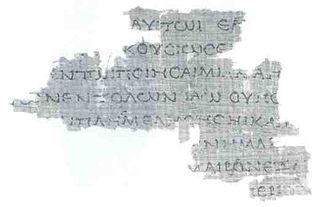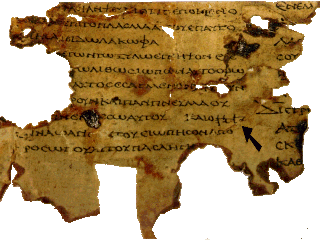
The Septuagint, sometimes referred to as the Greek Old Testament or The Translation of the Seventy, and often abbreviated as LXX, are the earliest extant Greek translations of the Hebrew Bible from the original Hebrew. The full Greek title derives from the story recorded in the Letter of Aristeas to Philocrates that "the laws of the Jews" were translated into the Greek language at the request of Ptolemy II Philadelphus by seventy-two Hebrew translators—six from each of the Twelve Tribes of Israel.

The Nash Papyrus is a collection of four papyrus fragments acquired in Egypt in 1902, inscribed with a Hebrew text which mainly contains the Ten Commandments and the first part of the Shema Yisrael prayer, in a form that differs substantially from the later, canonical Masoretic text and is in parts more similar to the chronologically closer Septuagint. It has been suggested that the text might have been the daily worship of a Jew living in Egypt at the time. The fragments comprise a single sheet and are not part of a scroll. The papyrus is of unknown provenance, although it is allegedly from Fayyum. The text was first described by Stanley A. Cook in 1903. Though dated by Cook to the 2nd century CE, subsequent reappraisals have pushed the date of the fragments back to about 150–100 BCE. The papyrus was by far the oldest Hebrew manuscript fragment known at that time, before the discovery of the Dead Sea Scrolls in 1947.
In contrast to the variety of absolute or personal names of God in the Old Testament, the New Testament uses only two, according to the International Standard Bible Encyclopaedia. From the 20th century onwards, "a number of scholars find various evidence for the name [YHWH or related form] in the New Testament.

In Christian scribal practice, nomina sacra is the abbreviation of several frequently occurring divine names or titles, especially in Greek manuscripts of the Bible. A nomen sacrum consists of two or more letters from the original word spanned by an overline.

The Tetragrammaton, or the Tetragram, is the four-letter Hebrew theonym יהוה, the name of God in the Hebrew Bible. The four letters, written and read from right to left, are yodh, he, waw, and he. The name may be derived from a verb that means "to be," "to exist," "to cause to become," or "to come to pass." While there is no consensus about the structure and etymology of the name, the form Yahweh is now accepted almost universally, though the vocalization Jehovah continues to have wide usage.

The Rylands Papyri are a collection of thousands of papyrus fragments and documents from North Africa and Greece housed at the John Rylands University Library, Manchester, UK. The collection includes the Rylands Library Papyrus P52, also known as the "St John's fragment", a fragment from a papyrus codex, generally accepted as the earliest extant record of a Canonical gospel.

Codex Marchalianus designated by siglum Q is a 6th-century Greek manuscript copy of the Greek version of the Hebrew Bible known as the Septuagint. The text was written on vellum in uncial letters. Palaeographically it has been assigned to the 6th century. Marginal annotations were later added to the copy of the Scripture text, the early ones being of importance for a study of the history of the Septuagint.

The Papyrus Fouad 266 are fragments, part of a papyrus manuscript in scroll form containing the Greek translation, known as the Septuagint, of the Pentateuch. They have been assigned palaeographically to the 1st century BCE. There is discussion about whether the text is original or a later recension of the Septuagint.

The manuscript 4Q120 is a Septuagint manuscript (LXX) of the biblical Book of Leviticus written on papyrus, found at Qumran. The Rahlfs-No. is 802. Paleographically it dates from the first century BCE. Currently the manuscript is housed in the Rockefeller Museum in Jerusalem.

Papyrus Oxyrhynchus 1007 is a fragment of a Greek Septuagint manuscript written on parchment. The manuscript was discovered in Oxyrhynchus, modern El-Bahnasa, Egypt. Using the study of comparative writing styles (palaeography), the manuscript has been dated to the 3rd century CE.

The Greek Minor Prophets Scroll from Nahal Hever is a Greek manuscript of a revision of the Septuagint dated to the 1st century BC and the 1st century CE. The manuscript is kept in the Rockefeller Museum in Jerusalem. It was first published by Dominique Barthélemy in 1963. The Rahlfs-Siglum is 943.

The Papyrus LXX Oxyrhynchus 3522, – is a small fragment of the Greek Septuagint (LXX) written in papyrus, in scroll form. As one of the manuscripts discovered at Oxyrhynchus it has been catalogued with the number 3522. Palaeographically it has been dated to the 1st century CE. The text agrees with the LXX.

Papyrus Oxyrhynchus 5101, designated by 2227, or P.Oxy.77 (LXXVII) 5101, is a manuscript of the Greek Septuagint Psalms, written on papyrus in roll form. It has survived in a very fragmentary condition. Using the study of comparative writings styles (palaeography), it has been dated to the middle of the first - middle of the second century CE.

The AqBurkitt are fragments of a palimpsest containing a portion of the Books of Kings from Aquila's translation of the Hebrew bible from the 6th century, overwritten by some liturgical poems of Yanai dating from the 9–11th century. This Aquila translation was performed approximately in the early or mid-second century C.E. The manuscript is variously dated to the 6th-century CE, or 5th-6th century CE.

Papyrus Oxyrhynchus 656 – is a Greek fragment of a Septuagint manuscript written on papyrus in codex form. This is a manuscript discovered at Oxyrhynchus, and it has been catalogued with number 656. Palaeographycally it is dated to late second century or early third century.
Papyrus Oxyrhynchus 4443 is a fragment of a Septuagint manuscript (LXX) written on papyrus in scroll form. It is the oldest extant manuscript that contains Esther 8:16–9:3 of the Septuagint text and verse numbering. according to the text of LXX. The manuscript has been assigned palaeographically to 50–150 CE.
AlbertPietersma is Dutch professor emeritus of Septuagint and Hellenistic Greek in the Department of Near and Middle East Civilizations at the University of Toronto‘s Faculty of Arts and Science.
Frank Edward Shaw is a retired professor and the originator of the theory that there was no single original form of writing of the name of God in the Greek Bible, instead of Ιαω, transliterations in square Hebrew characters, in paleo-Hebrew characters, Greek characteres ΠΙΠΙ, Θεὀς or, contrary to the more common opinion, of an original κύριος.
The Papyrus Chester Beatty V is a fragment of a Greek Septuagint manuscript written on papyrus. It belongs to the Chester Beatty papyri. Using the study of comparative writing style (palaeography), it has been dated to the late 3rd century CE.

The Papyrus Chester Beatty VI are fragments of a papyrus manuscript of the Greek Septuagint and one of the Chester Beatty papyri. It contains parts of the Book of Numbers and Deuteronomy. Using the study of comparative writing styles (palaeography), it has been dated to 200 CE.















